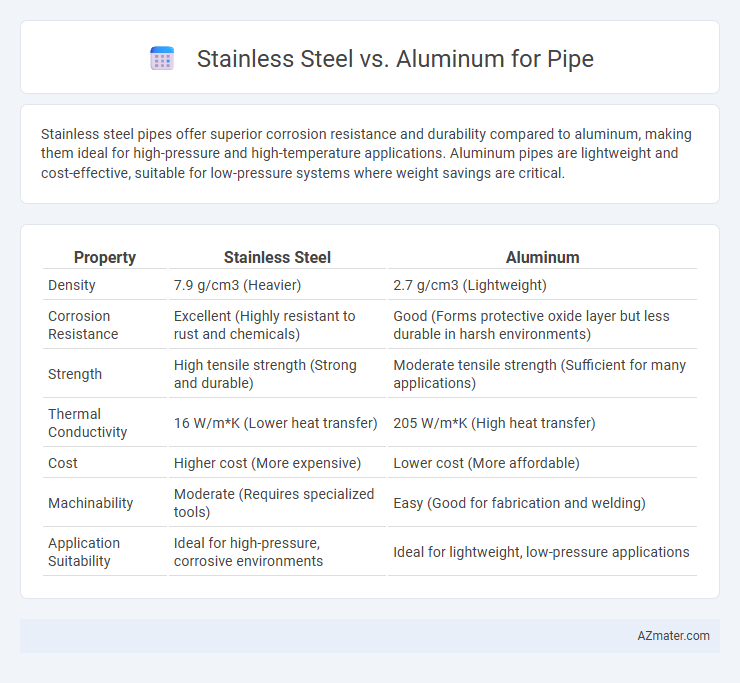Stainless steel pipes offer superior corrosion resistance and durability compared to aluminum, making them ideal for high-pressure and high-temperature applications. Aluminum pipes are lightweight and cost-effective, suitable for low-pressure systems where weight savings are critical.
Table of Comparison
| Property | Stainless Steel | Aluminum |
|---|---|---|
| Density | 7.9 g/cm3 (Heavier) | 2.7 g/cm3 (Lightweight) |
| Corrosion Resistance | Excellent (Highly resistant to rust and chemicals) | Good (Forms protective oxide layer but less durable in harsh environments) |
| Strength | High tensile strength (Strong and durable) | Moderate tensile strength (Sufficient for many applications) |
| Thermal Conductivity | 16 W/m*K (Lower heat transfer) | 205 W/m*K (High heat transfer) |
| Cost | Higher cost (More expensive) | Lower cost (More affordable) |
| Machinability | Moderate (Requires specialized tools) | Easy (Good for fabrication and welding) |
| Application Suitability | Ideal for high-pressure, corrosive environments | Ideal for lightweight, low-pressure applications |
Introduction: Comparing Stainless Steel and Aluminum Pipes
Stainless steel pipes offer superior corrosion resistance, high strength, and excellent durability, making them ideal for industrial and high-pressure applications. Aluminum pipes provide lightweight advantages, good thermal conductivity, and resistance to oxidation, which suits transportation and HVAC systems. The choice between stainless steel and aluminum pipes depends on factors such as environmental exposure, mechanical stress, and budget constraints.
Key Properties of Stainless Steel Pipes
Stainless steel pipes offer superior corrosion resistance, high tensile strength, and excellent durability compared to aluminum, making them ideal for high-pressure and high-temperature applications. Their resistance to oxidation and chemical exposure ensures long-term performance in harsh environments, while maintaining structural integrity and minimal maintenance requirements. Stainless steel's non-porous surface also resists bacterial growth, making it essential for sanitary and food-grade piping systems.
Key Properties of Aluminum Pipes
Aluminum pipes are lightweight, offering excellent corrosion resistance and high thermal conductivity, making them ideal for applications requiring efficient heat transfer. Their high strength-to-weight ratio provides durability while reducing overall system weight compared to stainless steel pipes. Aluminum also exhibits good machinability and is non-magnetic, which benefits specific industrial and architectural uses.
Corrosion Resistance: Stainless Steel vs Aluminum
Stainless steel offers superior corrosion resistance compared to aluminum, particularly in harsh environments such as marine or chemical settings, due to its chromium content forming a passive oxide layer. Aluminum resists corrosion primarily through its natural oxide film, which can be compromised in acidic or saline conditions, leading to pitting or galvanic corrosion. Choosing stainless steel for piping ensures longer durability and reduced maintenance in corrosive environments, while aluminum is suitable for less aggressive conditions where weight savings are critical.
Strength and Durability Comparison
Stainless steel pipes offer superior strength and corrosion resistance compared to aluminum, making them ideal for high-pressure and harsh environmental applications. Aluminum pipes are lightweight and corrosion-resistant but lack the tensile strength and durability of stainless steel, which limits their use in heavy-duty or high-stress conditions. The enhanced mechanical properties and longevity of stainless steel ensure lower maintenance costs and better performance in demanding pipeline systems.
Weight Differences and Installation Impact
Stainless steel pipes are significantly heavier than aluminum pipes, with stainless steel weighing approximately 8,000 kg/m3 compared to aluminum's 2,700 kg/m3, impacting transportation and handling during installation. The weight difference makes aluminum pipes easier and faster to install, especially in applications requiring long spans or overhead placement, reducing labor costs and effort. However, stainless steel's higher density provides superior strength and durability, which may justify the added weight in demanding industrial environments.
Cost Analysis: Stainless Steel vs Aluminum Pipes
Stainless steel pipes typically have a higher initial cost compared to aluminum pipes, largely due to the raw material prices and manufacturing processes involved. Aluminum pipes offer a cost advantage in terms of lightweight handling and lower transportation expenses, making them economical for large-scale projects. Maintenance costs for stainless steel are generally lower due to its superior corrosion resistance, which can offset the initial investment over time.
Applications and Industry Suitability
Stainless steel pipes are preferred in industries requiring high corrosion resistance, strength, and temperature tolerance, such as chemical processing, food and beverage, and oil and gas. Aluminum pipes offer lightweight and excellent corrosion resistance in marine, automotive, and aerospace applications where weight reduction is critical. Selection depends on performance requirements, with stainless steel favored for durability and aluminum for cost-effective, lightweight solutions.
Maintenance and Longevity Considerations
Stainless steel pipes offer superior corrosion resistance and require less frequent maintenance compared to aluminum, making them ideal for long-term applications in harsh environments. Aluminum pipes are lightweight and resist oxidation but may need more regular inspections and protective coatings to prevent wear and degradation. Choosing stainless steel enhances durability and reduces maintenance costs, while aluminum is suitable for applications where weight savings outweigh longevity concerns.
Conclusion: Choosing the Right Material for Your Pipe Needs
Stainless steel offers superior corrosion resistance, strength, and durability, making it ideal for high-pressure and high-temperature applications. Aluminum provides lightweight flexibility and excellent thermal conductivity, suitable for low-pressure and temperature settings where weight reduction is critical. Selecting the right pipe material depends on specific project requirements such as environmental exposure, mechanical stress, and budget constraints to ensure optimal performance and longevity.

Infographic: Stainless steel vs Aluminum for Pipe
 azmater.com
azmater.com